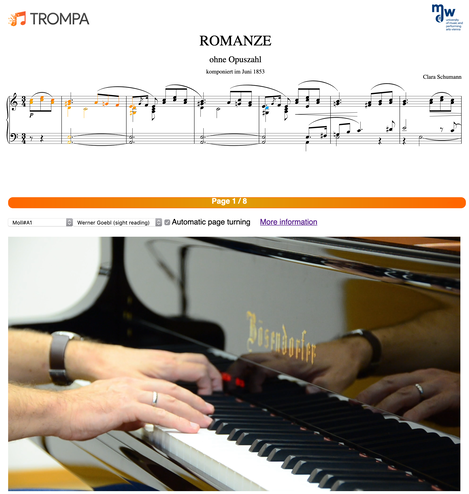Clara Schumann 200
David M. Weigl & Werner Goebl, IWK, mdw
On the occasion of Clara Schumann's 200th birthday on September 13th, 2019, we present a first version of our rehearsal companion (https://trompa.mdw.ac.at).
In this first version, the rehearsal companion consists of a visualisation interface that displays the score and highlights the notes as they are played by the performer. Behind the scenes, we are using a Linked Data (MELD) framework for linking semantic digital notation (an automatic engraving of an MEI file using Verovio) with the performance employing the "Symbolic Music Alignment Tool" by Eita Nakamura to match each performed note with the corresponding notated note in the score.
A future version of the reheasal companion will match the performance to the score and highligh the notes in real time. The captured performance MIDI stream—characterising note events according to their pitch, duration, and attack velocity—is aligned with the MEI-encoded score using Linked Data (RDF) structures according to the MELD semantic framework. Thus exposed, the alignment information is made available for immediate reuse, e.g., to review one's own performance, or to audit and compare different interpreters' renditions of the same score.
This web application, implemented using the MELD-clients-core Javascript libraries, presents digital score notation (rendered from MEI encodings using the Verovio engraving tool) augmented with real-time note highlighting corresponding to current performance position, coloured according to attack velocity.
By anchoring within the comprehensive musical model of the MEI schema, but lifting the alignment structures themselves into the higher layers of abstraction offered by Linked Data, the score-synchronised performances become available for annotation and interlinking within a wider Web of data. This provides a foundation for the enrichment of public-domain music materials available on the Web, both by software processes, and by musicians, music scholars, and music enthusiasts, as envisioned by the TROMPA project.
How to use the Rehearsal Companion demo
- Select a performance rendition from the selector below the score.
- Press play at the video, if playback does not start automatically (depends on your browser)
- Select a section of the piece (for the Romanze A1, B, A2) so that the player jumps straight to that position
- You may also klick on individual notes in the score to make the player jump to that note
- Switch off the automatic page turning and navigate through the pages of the score yourself; switch it on to let the system turn pages for you
Color coding
- Performed notes are colored from yellow (very softly played) to red (very loudly played).
- Blue notes are notes missed by the performer.
- Inserted notes (additional notes by the performer not in the score) are not shown in this demo.
 This is part of TROMPA, a research and innovation action supported by the European Commission under H2020-EU.3.6.3.1. under grant agreement No 770376.
This is part of TROMPA, a research and innovation action supported by the European Commission under H2020-EU.3.6.3.1. under grant agreement No 770376.
